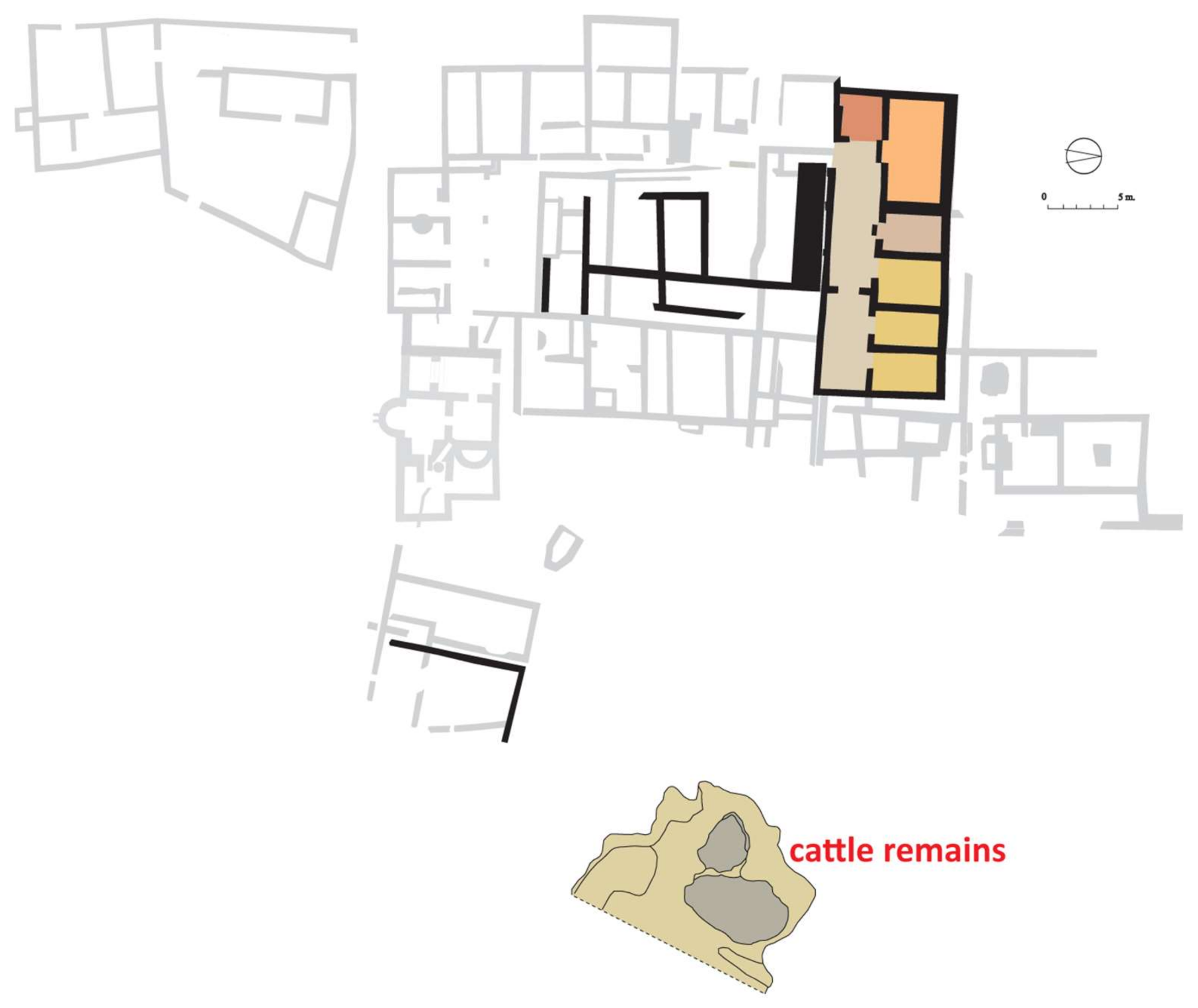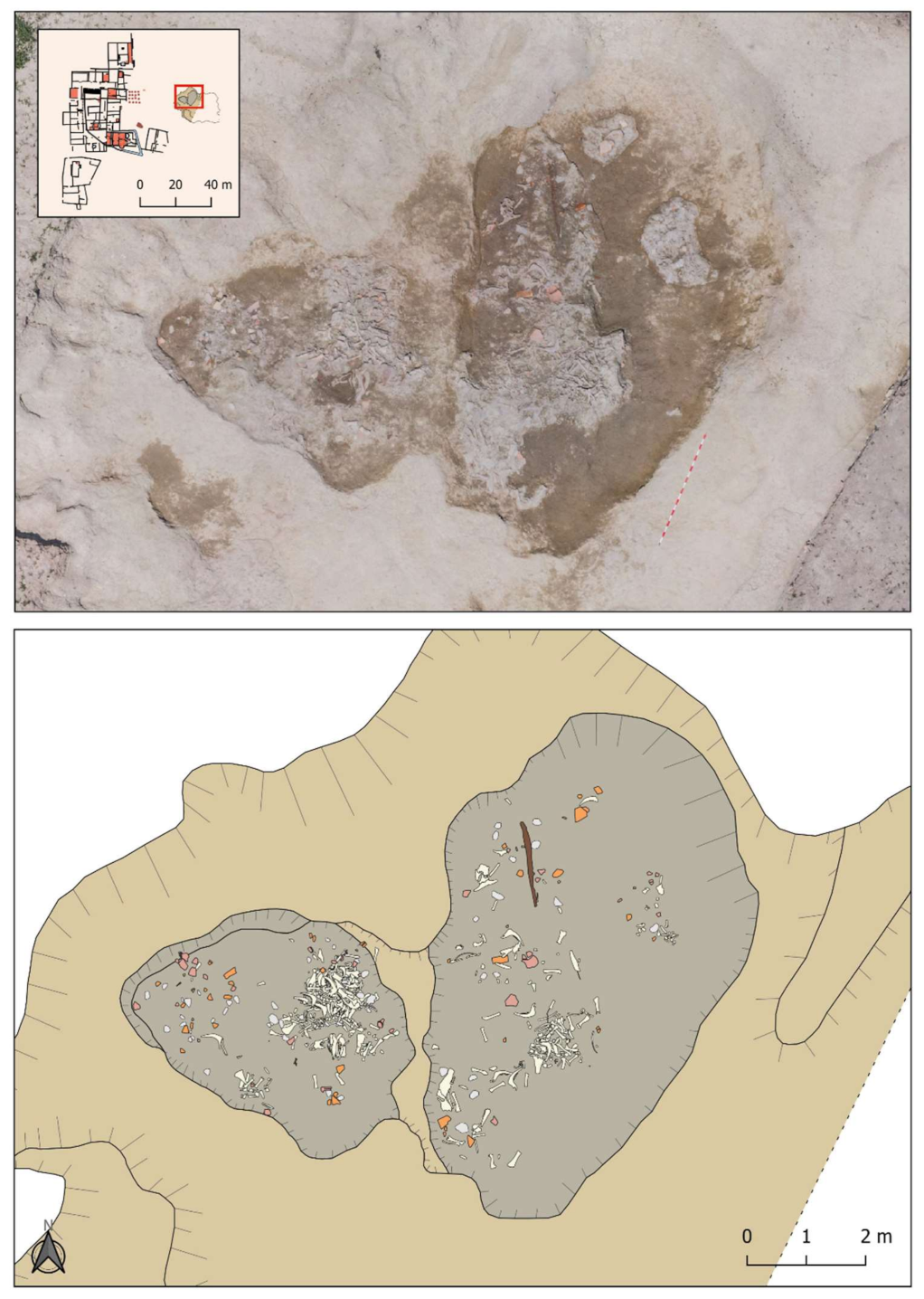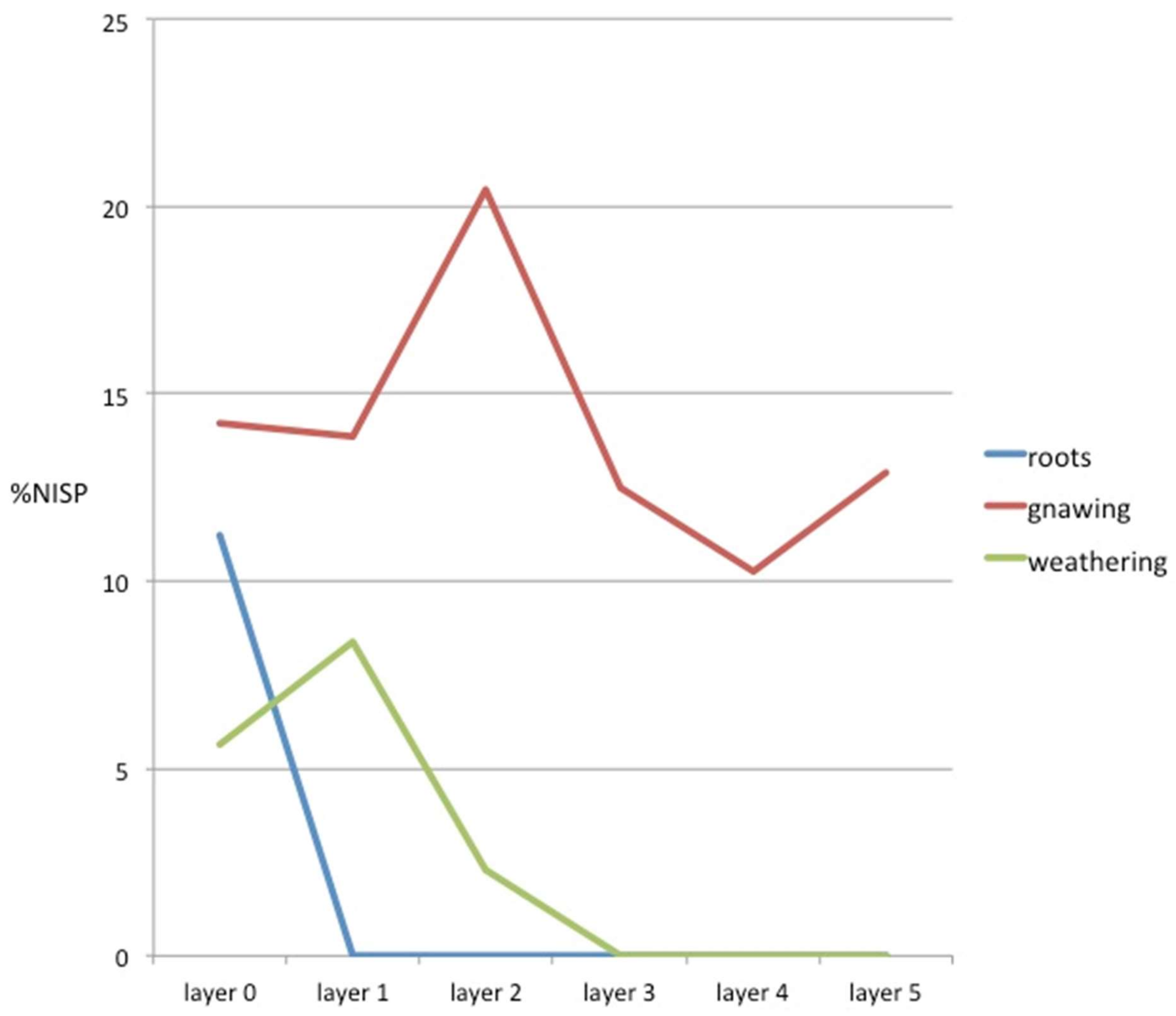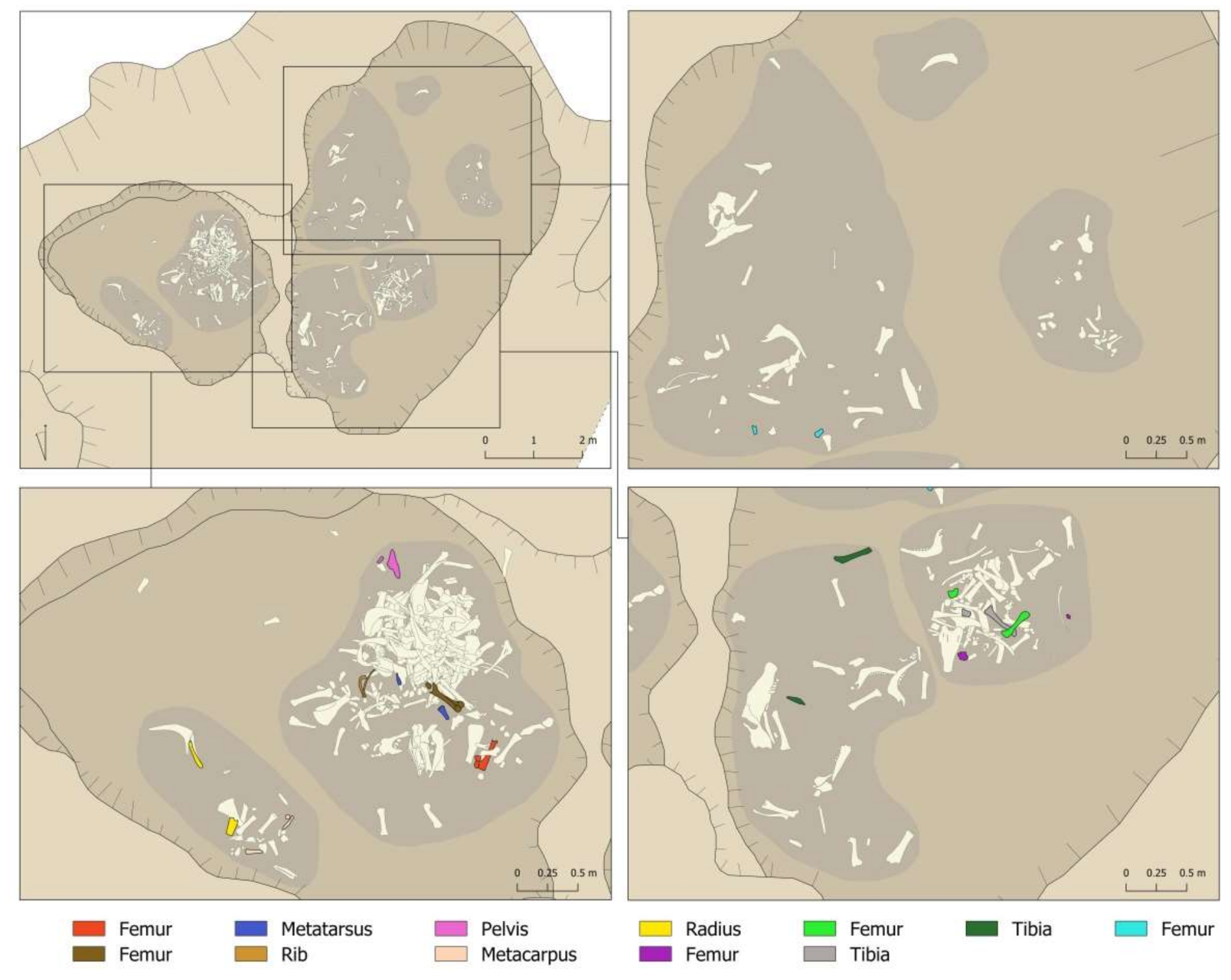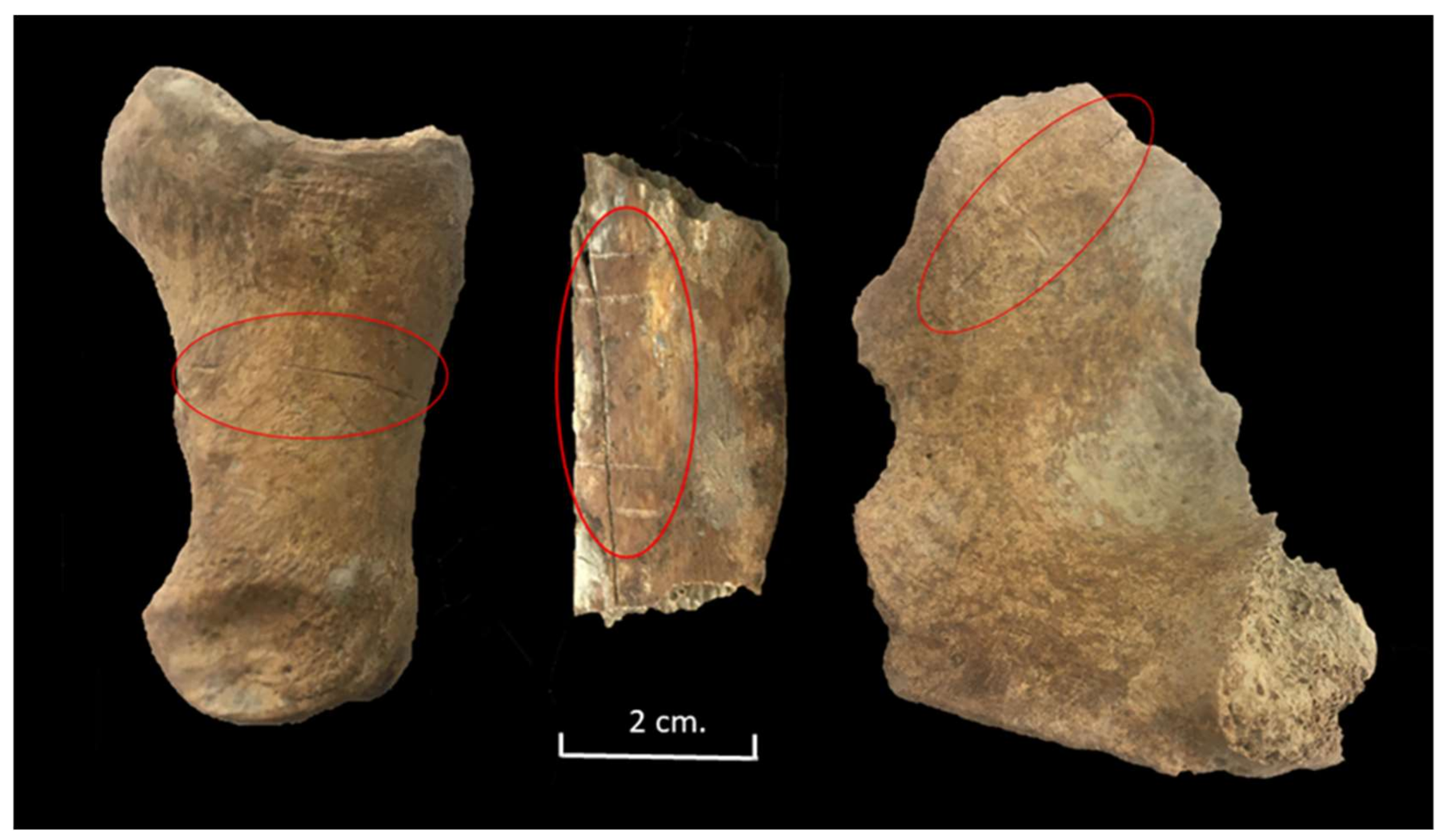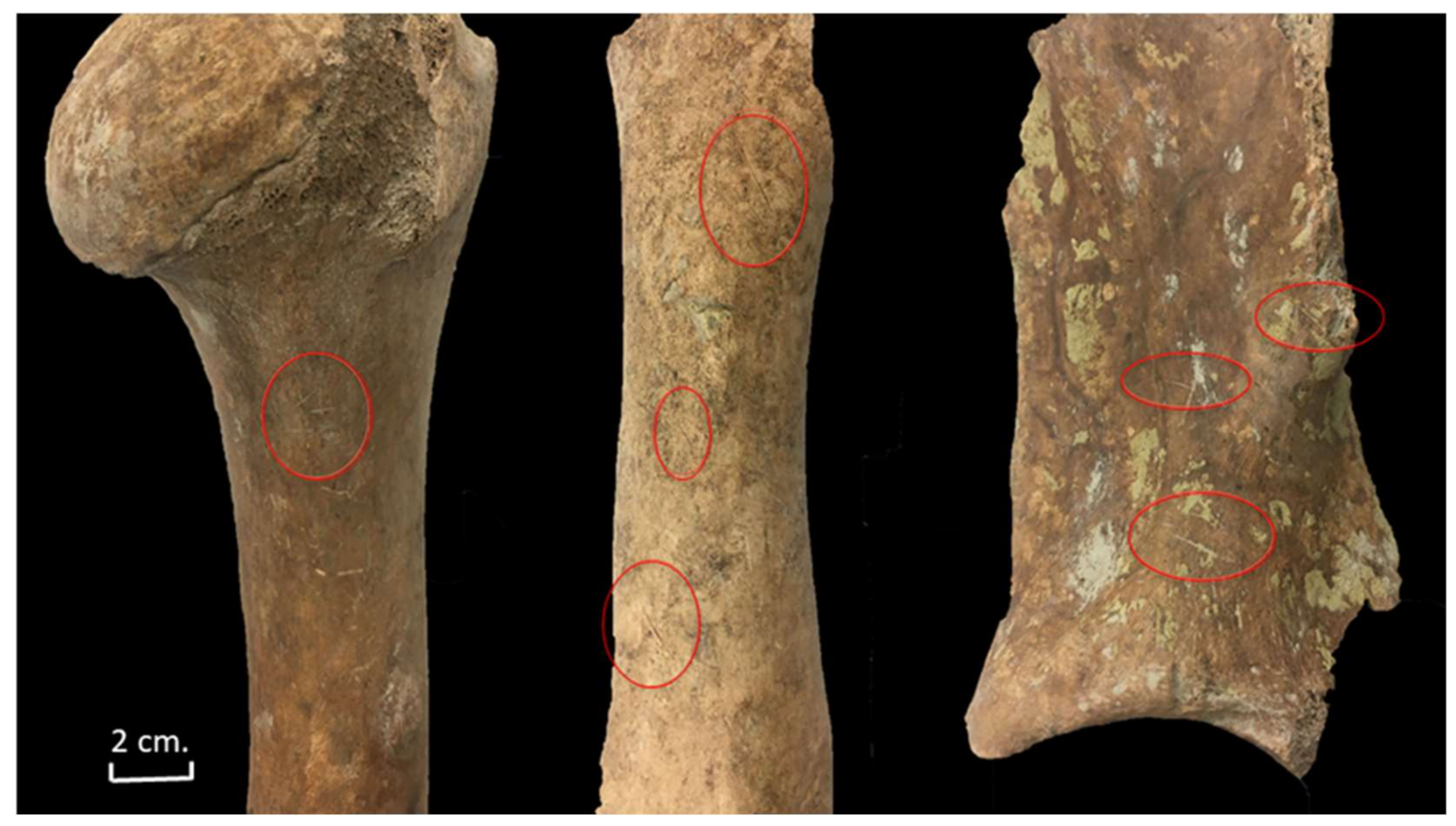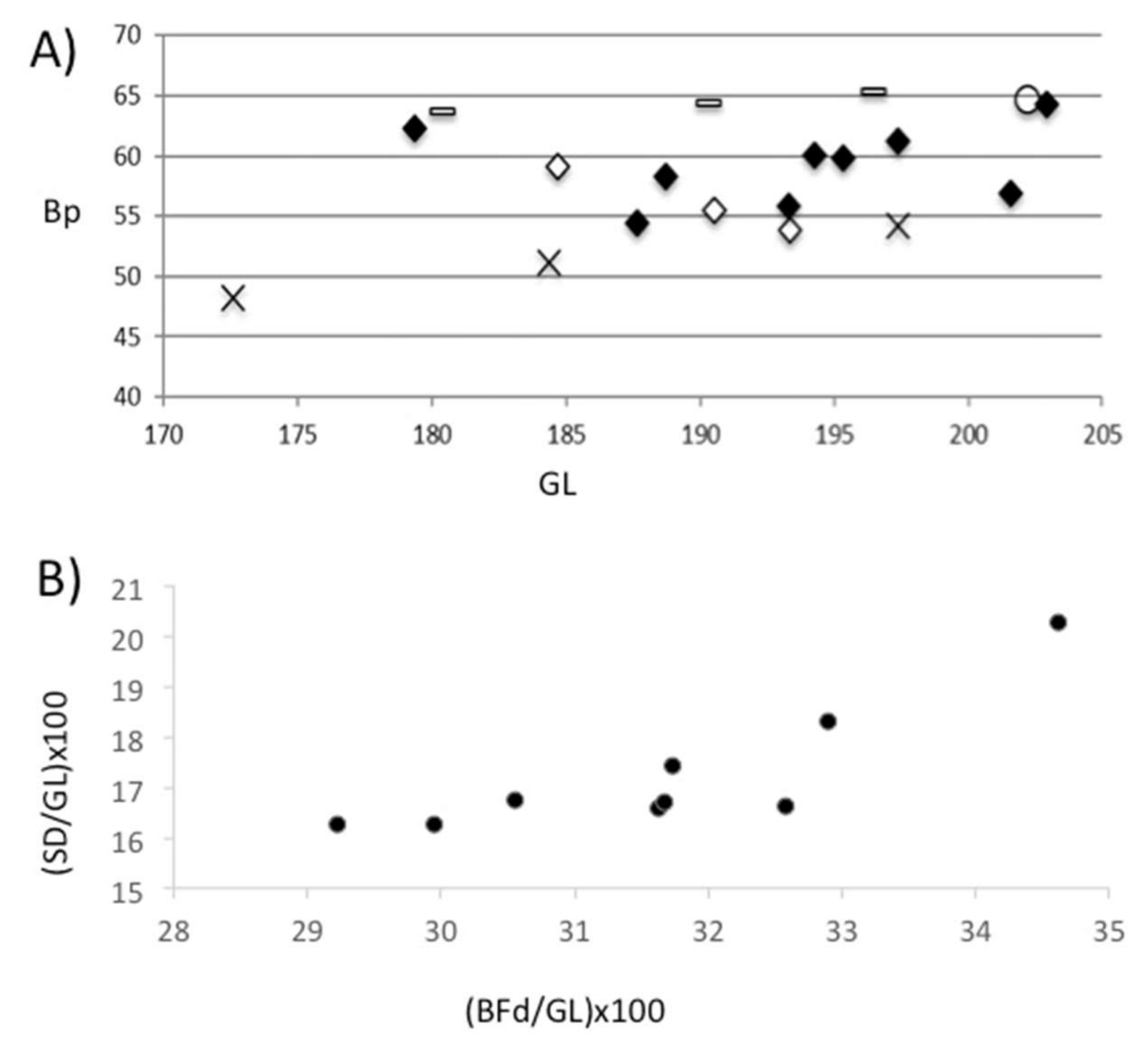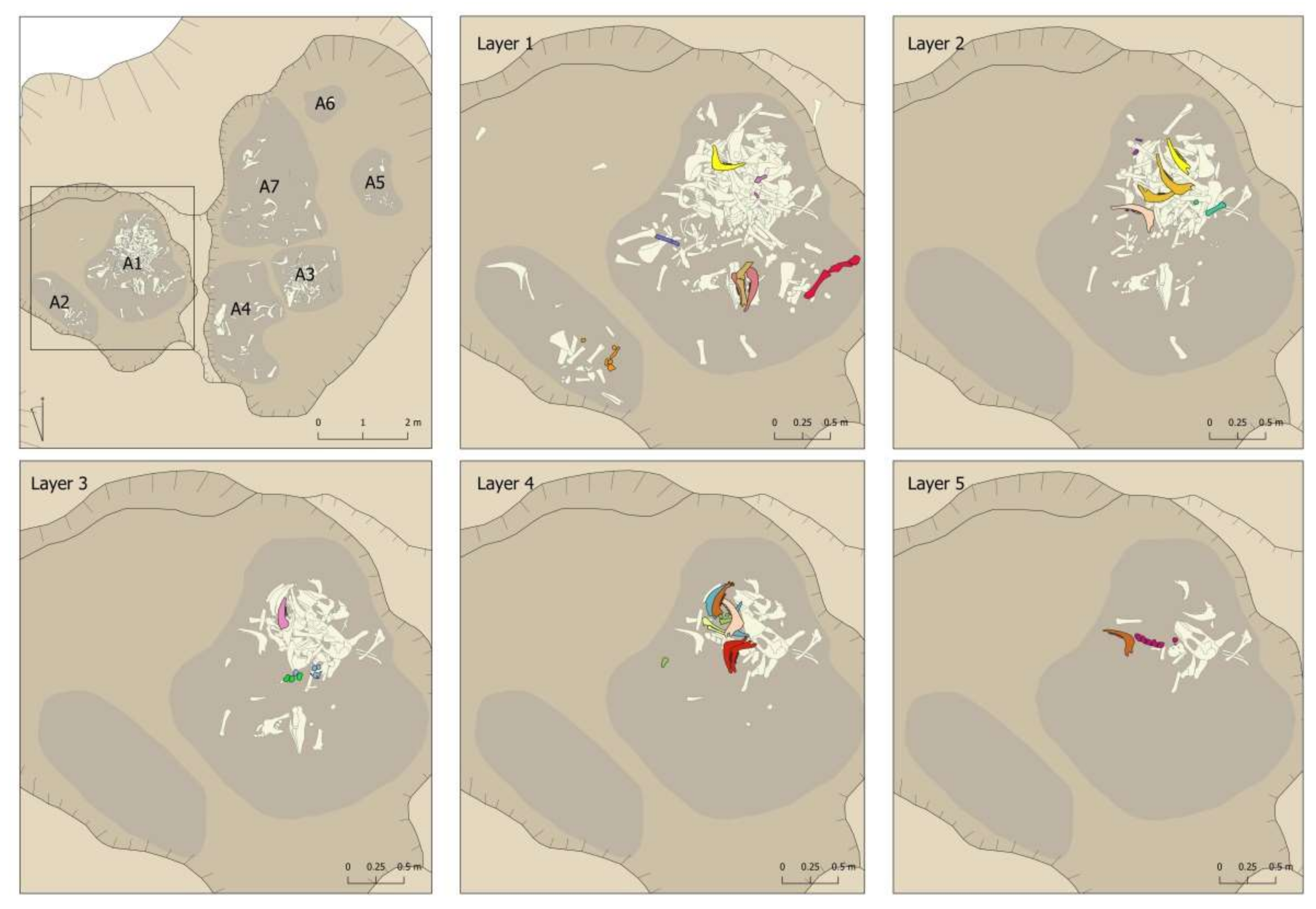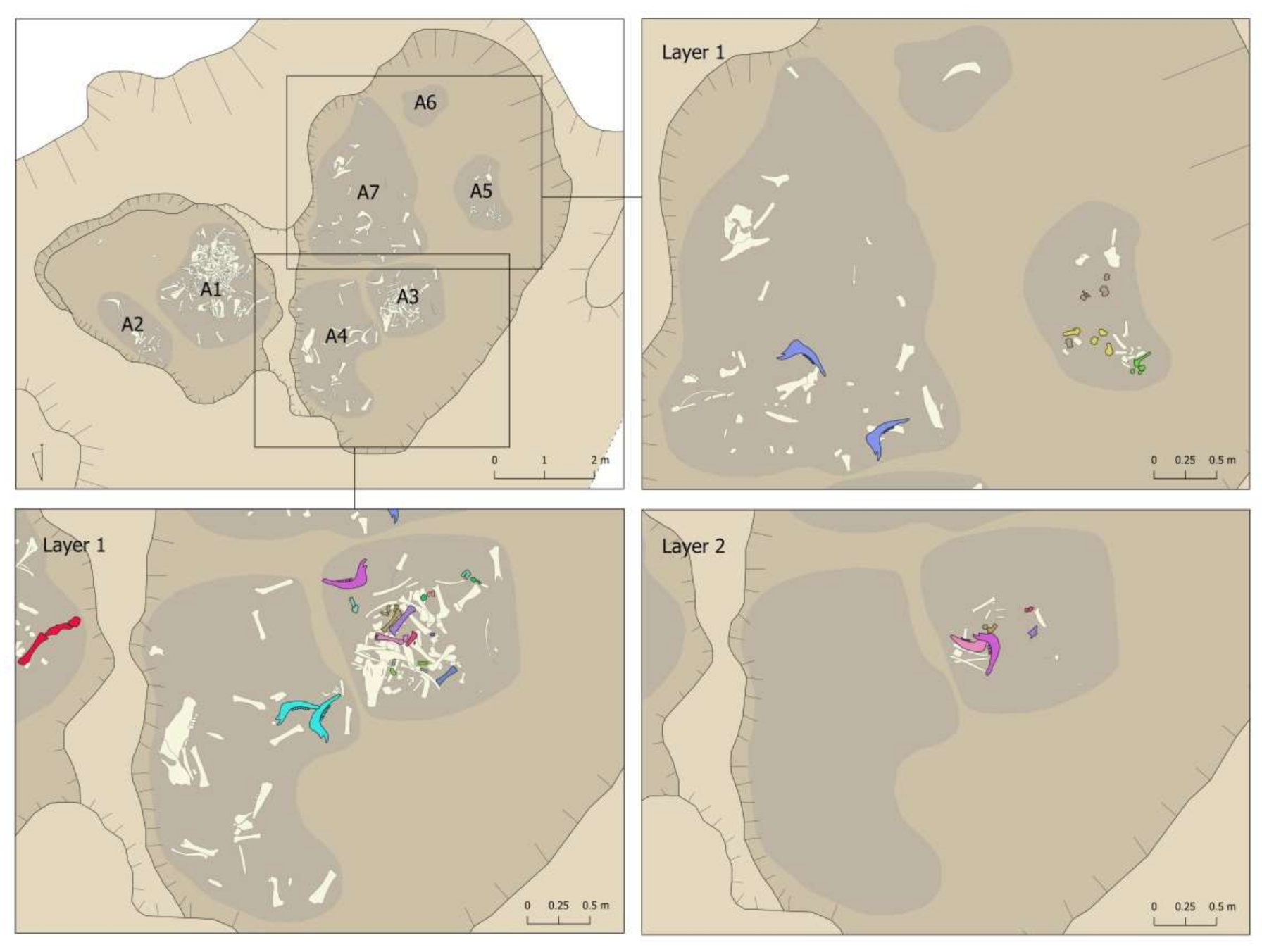1. Introduction
Bones from archaeological sites are the remnants of a wide range of activities. They are usually refuse from domestic meat consumption, although they can also be butchery deposits; waste from activities linked to hide preparation, bone and antler working, or glue manufacture; deposits created for the hygienic management and disposal of animal carcasses; or ritual deposits, to name only some of the possibilities. During the Roman period, large deposits of bones were accumulated as waste from those activities. Several guidelines to define their characteristics have been proposed to help identify the activity that generated them.
Large numbers of terminal limb elements (carpals, tarsals, metapodials, and phalanges), in association with a high proportion of heads, are considered indicative of waste from primary butchery [
1,
2,
3]. In contrast, a preponderance of fractured large bones, scapulae, pelvises, vertebrae, and ribs has generally been considered an indication of domestic waste [
2,
4]. Once the animal had been slaughtered, however, several products other than meat were of interest for a variety of productions. An abundance of horns, feet, and tails has been associated with tanneries and hide preparation [
5,
6]. A large number of antlers and fully fused sawn metapodials, accompanied by half-finished artefacts, has been related to antler and bone working [
7,
8,
9,
10,
11,
12]. Deposits composed of diaphyses from systematically broken long bones have been proposed as the refuse from glue manufacture and marrow extraction [
6,
13,
14,
15]. Other deposits contain entire animal carcasses, with no evidence of anthropic modification. These have been interpreted as a deliberately symbolic acts, or as a means of disposing of dead animals whose carcasses were not processed, either because the animals were ill when they died or because their meat was not generally eaten (e.g., dogs and equids during the Roman period) [
13,
16].
This summarised list is obviously very simplistic, and the true picture at any site is likely to have been far more complex and possibly include more than one origin. An example of this complexity is the case presented in this paper. Here, we present a deposit of 783 cattle remains that filled a 187 m2, irregularly shaped hole located in front of the Roman villa of Vilauba (Catalonia). The characteristics of this assemblage do not match any previously presented parameters. At the same time, an assemblage consisting mainly of cattle remains such as the one presented here had never been documented at the site. To understand the nature and formation of this singular assemblage, and therefore elucidate the economic importance of this species for the inhabitants of the villa, we undertook a detailed archaeozoological study combined with a GIS analysis. This approach allowed us to answer key questions in the final interpretation of the deposit, such as the degree of homogeneity in the assemblage, the primary or secondary deposition of the remains, and the degree of completeness of the carcasses. This enabled hypotheses to be put forward on the activity that could have generated it, and a baseline to be created for future studies.
2. The Site of Vilauba
The villa of Vilauba is in a small valley 3 km south of Lake Banyoles (Girona, Catalonia) (
Figure 1). Thorough scientific research has revealed more than 5000 m
2 of archaeological remains spanning from the 2nd–1st century BC to the 7th century AD [
17].
The aim of the Vilauba Roman villa archaeological research project is the comprehensive excavation of this rural establishment. This will help add to our knowledge of the forms of occupation and exploitation of this territory between the early Roman occupation and the end of the ancient world.
Despite the attested evidence of occupation prior to the turn of era, the first well-known stage of the archaeological site corresponds to a building from the 1st century AD that was successively reformed and in use until the end of the 3rd century AD. From the first building we know mainly of the residential area with a rectangular ground plan. It was divided longitudinally into two halves, corresponding to a corridor or frontal gallery and a row of six rooms in the rear (pantry/kitchen, triclinium, sacellum, and three bedrooms). To the south, other rooms surrounded a small courtyard or open area whose function is more difficult to attribute [
17] (pp. 55–76) (
Figure 2). The working area was separated from the residence and has been interpreted as livestock stables and facilities for farming-related activities [
17] (pp. 102–105).
The study of these two sectors shows that Vilauba, although it was a modest villa, would have been quite important in its territory, with a theoretical farmed area of between 50 and 85 hectares in this early Roman phase [
18] (p. 20). The different seed species identified (wheat, barley, olive, grape, pea, and lentil) suggest that the villa’s lands were farmed throughout the annual cycle. Wheat and barley would have been sown in autumn and legumes planted in spring [
19]. At the same time, archaeozoological studies show that sheep, goats, pigs, and cattle were bred at the villa. These animals would have been used mainly to provide wool, milk, meat, and traction [
20] (pp. 77–92). They would also have provided fertiliser for the fields. Thus, the inhabitants of the villa of Vilauba would have practised a diversified economy characterised by a combination of crop cultivation and stockbreeding.
2.1. Stratigraphy of the Pit and Its Relation to the Villa’s Occupational Sequence
Although the general periodisation of the Vilauba site can be summarised in three major stages, the archaeological record shows that the final ground plan of each stage was the result of a much more complex process that often involved significant reforms and modifications within each period. Thus, the early Roman villa (1st–3rd centuries AD) should be understood as the final result of a process that began much earlier with the construction of a small residential building in the northern sector that occupied a large rectangle some 25 m long and 9 m wide [
17] (pp. 55–76), [
21] (p. 36). The finds excavated below the current use levels that can be associated with the prior levelling of the terrain allow the construction of this north wing to be dated to around 60 AD. It is precisely considering the dating of this sector of the residential villa that we can associate its construction, both stratigraphically and chronologically, with the large pit where the bone remains we will analyse in detail in this study were found (
Figure 2).
The pit was discovered during the geophysical survey carried out in the eastern part of the site (
Figure 3). It detected various anomalies, including, of particular note, Groups A and B, which were part of the same complex with a very high magnetic signal bordered by a large negative cut. The remarkable size of this cut, 18 m long and a minimum of 13 m wide, meant that it was first necessary to excavate Anomaly A, which was larger and deeper, and leave Anomaly B for future campaigns [
22] (p. 226).
The pit was more or less round in shape, although its outline was quite irregular. Stratigraphically, its borders could be perfectly defined, as the soil of the inner backfill contrasted clearly with the colour and composition of the clays that make up the natural sedimentation (
Figure 4, U.S. 1693). The excavation made it possible to identify the different stratigraphic units that formed a brief sequence of up to four superimposed levels that could be clearly differentiated from each other and had a total depth of 120 cm. In addition to the surface level removed by more recent agricultural work, these stratigraphic units were identified by record numbers 1694, 1696, 1697, and 1700 (
Figure 4).
The study of the characteristics and composition of the stratigraphies and finds allowed us to reconstruct different phases of the process of the pit’s backfill. The three upper stratigraphic units (U.S. 1694, 1696, and 1697) contained large amounts of archaeological finds, especially pottery, as well as pieces of glass, metal, and other materials. In contrast, the lower level (U.S. 1700) was formed mainly of a large number of faunal remains covered by colluvial clays. The study of the characteristics and composition of the stratigraphy and finds allowed us to reconstruct different phases of the process of the pit’s backfill. The three upper stratigraphic units (U.S. 1694, 1696, and 1697) contained large amounts of archaeological finds, especially pottery, as well as pieces of glass, metal, and other materials. In contrast, the lower level (U.S. 1700) was formed mainly of a large number of faunal remains. Most of these remains were from large animals that had apparently been dumped at random, although some fragments still maintained their anatomical connection (
Figure 4, Phase 2A). Although the bone remains formed perfectly differentiable groupings, some fragments appeared more dispersed and mixed with the same colluvial clays that also covered the larger concentrations. The presence of these clays indicates stratigraphically that after the bone remains had been dumped, the pit had been left open for a short time, allowing for the deposition of the colluvial level (
Figure 4, Phase 2B). Although fewer archaeological finds were made among the bone remains, the absence of pottery of African origin, which was present in the higher levels, allows us to place its formation around the years 50–60 AD.
The dumping of these bone remains (U.S. 1700) thus stratigraphically marks the beginning of the backfill of a large open pit dug in the natural terrain near the villa. The characteristics and size of this enormous hole, as well as the absence of any trace of interior preparation, make any interpretation linked to the Roman villa’s agricultural activities impossible. The hypothesis that seems most feasible to us is that it was dug to obtain the clay needed to build the walls of the residential building and, more specifically, the villa’s north wing (
Figure 2 and
Figure 4, Phase 1). The natural sedimentation on which the villa of Vilauba was built, formed by clayey silts of a beige-green colour, is especially suitable for building walls, one of the parts of the work that required the greatest volume of material. Use of the natural resources offered by the surrounding area, including for construction, was, according to the ancient Latin agronomists, one of the fundamental precepts of Roman villas. The proximity of this pit to the building would have helped optimise the work and avoid transportation costs.
Above the lower level, the backfill of the pit was formed by two intermediate stratigraphies (1696 and 1697) with a very similar composition and chronology (
Figure 4, Phases 3A and 3B). From its excavation, we can highlight the large amount of building waste, iron slag, and pottery, with a wide repertory of common ware, cookware and wine, and olive oil and salted fish amphorae. Some tableware and imports were also found, with a clear predominance of Hispanic and southern Gallic Samian ware. There were also some pieces of fine-walled and North African pottery, particularly cookware, but also some of the first forms of African A tableware (Hayes 3A and 8A). This allows us to place the terminus post quem of this stratigraphic unit around the last decade of the 1st century AD. Finally, the upper level (U.S. 1694) corresponds to a last levelling of the pit, and it can be dated in the first half of the 2nd century AD.
5. Discussion
The detailed archaeozoological and GIS analysis shown above, combined with the information obtained from the stratigraphic record, allowed us to consider some hypotheses regarding the origin and formation of this assemblage of cattle remains.
The excavated archaeological stratigraphy showed that the bone remains were dumped immediately after the clay had been extracted, as the layer of bones (U.S. 1700) was deposited directly on the bottom of the pit (
Figure 4, Phase 2A). With regard to the formation of the deposit itself, we propose that this was carried out unitarily over a very short period of time, as evidenced by the absence of colluvial levels between the bone layers. The study of the natural and anthropic modifications presented here corroborated this statement, as all the remains presented a similar taphonomic history and were affected by the same biological agents (gnawing). The general absence of weathering (which only affected 5% of the assemblage) and total absence of sedimentary abrasion and trampling in all layers and areas also showed that this assemblage did not have a complex taphonomic history, but quite the opposite.
The fact that some of the remains of the most superficial layers of the deposit were altered by the action of water and roots could be an indication that these last layers were in the open air for a longer period before being permanently covered. The presence of bone remains from other species in the surface level (Layer 0), resulting from the habitual consumption of the villa’s inhabitants, would also fit this interpretation. It is also supported by the stratigraphy itself, since the bone remains were covered by colluvial clay (
Figure 4, Phase 2B). Shortly afterwards, when the bones had been mostly covered by clay and vegetation, the pit was permanently filled with construction and consumption remains and other debris (UEs 1697, 1696). The most modern finds in these stratigraphies allowed us to place their formation around the last decade of the 1st century AD.
Therefore, based on this evidence, we suggest that the cattle assemblage under study here was a homogeneous deposit. The presence of several articulated partial skeletons documented during and after excavation in all layers and areas of the deposit suggests that the context in which they were found is a primary deposit. This fact is also shown by the lack of diverse natural alterations in the remains, indicating that they did not come from different assemblages with different taphonomic histories, but quite the opposite.
We therefore propose that we are looking at a homogeneous assemblage in a primary position that was dumped in the pit during a brief time. During that time, however, canines gained access to the remains and gnawed on a few of the elements (113 remains). However, we considered that the impact of carnivores on the assemblage is not only evident from the marks they left on the remains, but also from the fact that connections were documented during the laboratory work that had not been observed in the field and were a result of the displacement of the remains by the canines when they accessed the pit. On the other hand, the documented anatomical representation is quite homogeneous among the long bones, jaws, pelvises, scapulae, and skulls. In contrast, there are certain elements that are underrepresented, mainly at those upper levels. They are those with a lower structural density, such as the vertebrae and ribs [
43,
44,
45,
46], or smaller bones such as carpal or tarsal bones, phalanges, patellae, etc.
Given these considerations, we consider that the anatomical representation documented in the pit was not just the result of human intervention (such as the result of skinning). We also consider that dogs gnawed some bones, displaced others, and also could have been responsible for a few of them disappearing altogether once ingested. These would have been mainly the smaller, lower-density bones from the upper levels. The action of dogs on animal-remain deposits, resulting in a differential preservation due to the ingestion of less dense and/or smaller bones, is well documented archaeologically [
47,
48,
49].
If we assume that gnawing, together with human action, could have contributed to the biases in the assemblage, we can propose that this pit was filled with whole cattle skeletons. The fact of having documented connections throughout the deposit, a similar number of right and left elements, together with a similarity of ages between the right and left jaws and the long bones, allowed us to propose that all these elements would have corresponded to the skeletons of some 14 individuals.
They were predominantly males and females, although we also documented the presence of castrates, with a withers height of between 111 and 140 cm (average 123 cm). These individuals had slightly higher withers heights than those documented in other contexts of the villa, ranging from 107 to 122 cm. The study of age at death shows that they were all adults when they died, with a predominance of 6- to 8-year-old individuals, except for one individual that was 2–3 years old and two individuals that were 8–10 years old. These ages at death are similar to the slaughter patterns documented during the early Roman phase of the villa, with a clear predominance of animals slaughtered at adult and older ages [
20,
50]. Therefore, these ranges of ages would be the predominant cattle ranges of age present at the villa. Thus, considering the profiles of the 14 individuals excavated, we could conclude that most of these animals were probably part of the villa’s workforce (draught animals, but also for breeding and traction). It must be highlighted that two metatarsals and one metacarpal were present an enlargement of the medial trochlea, which can occur in those animals repeatedly exploited as draught animals [
51].
We were also able to document that these carcasses were dumped in the pit after being processed, as shown by the fact that a fairly high number of marks were recorded (on 12.3% of the remains). The study of the type of mark and their location and orientation revealed that, once slaughtered, the individuals had probably been beheaded, stripped, eviscerated, partially dismembered, and skinned. All this, however, was carried out without fracturing the bones.
There are many studies that demonstrate how the processing of carcasses in Roman times followed fairly standard guidelines [
33,
52,
53,
54,
55,
56]. It has been suggested that, once the head had been removed, the fore and hind limbs were the first parts to be detached from the body, leaving the rib cage, vertebrae, and pelvis as a unit. After removing the limbs, the carcass was split. Final processing would have taken place to reduce the carcass to portions suitable for cooking [
34]. The most widely used tool was the cleaver, a large butcher’s knife used for intensive slicing and dismemberment to maximise the amount of meat obtained from each individual, cutting the bones to quarter and dismember the carcass [
52,
53,
54,
55,
56].
Therefore, we propose that some 14 cattle carcasses were processed in a short time, but not in the usual way documented in other assemblages excavated at the villa interpreted as waste from culinary preparation and consumption [
20], nor as the usual way proposed for Roman times [
33,
52,
53,
54,
55,
56]. We can rule out the possibility that we are dealing with a classic waste dump from domestic meat consumption. Neither does it appear to be butchery waste since, the possible bias caused by the dog actions notwithstanding, the assemblage under study is made up of elements of the whole skeleton. Heads, the distal and proximal parts of limbs, and trunk elements were documented. Neither is it a deposit formed by the waste from activities linked to hide preparation, bone and antler working, or glue manufacture. As explained in the introduction, several studies propose that such deposits consist of specific elements with certain fracturing patterns that were not documented here. Moreover, that type of waste is usually generated in urban contexts where there is a large agglomeration of people.
The characteristics and nature of the Roman villa of Vilauba, a rural establishment with modest residential buildings and various facilities intended for the agricultural exploitation of the most immediate territory, with a maximum estimated population of between 25 and 30 people, leads us to rule out the option that these cattle were slaughtered for the inhabitants’ own consumption. Likewise, the hypothesis of a banquet or large celebration for hundreds of invitees seems equally unlikely if we take into account the mainly agricultural nature of the establishment and the settlement structure in this territory, which was marked by small scattered rural establishments and a single urban nucleus, Gerunda, certainly of very modest size. The biomass calculation carried out in
Section 4.7 shows that between 1.3 and 2 tons of meat could have been obtained from these 14 individuals. This could have fed from some 2600 people (500 g per person) until several thousand people (100 g per person) at a time, a totally ruled out possibility if we take into account the territory in which the villa was located. The constructive and architectural characteristics of the urban part of the Vilauba villa, very far from the models of other Roman villas with a clearly residential vocation, with numerous rooms decorated with mosaic pavements and rich pictorial decorations, or large reception and representation rooms, also do not suggest the possibility of large-scale celebrations. In this same sense, the absence of any ritual evidence or ritual connotation in the assemblage (as has been explained in
Section 2.1), as well as of any other indicator of a cultic nature in the pit itself or in the settlement, leads us to rule out a possible interpretation of the carcasses as a commemorative or religious deposit.
Another option is that the slaughter of these 14 individuals was not due to an action planned over time, as it involved a large quantity of meat being suddenly available. One possibility is that they may have contracted some kind of disease, and it was decided to slaughter them in order to take advantage of their meat. The Latin agronomists describe many diseases as having been common in cattle, including indigestion, stomach aches, dysentery, infections, fevers, coughs, abscesses, lameness, scabies, ulcers, and wounds (Columella, De re rust., I, VI, 1–19; Paladius, Op. agr., XIV). The majority of these illnesses do not leave traces in the bones. In this case, we propose that they would have contracted a disease that would have allowed most of their meat to be taken advantage of. This possible disease would have affected those cattle that predominated in the villa: mainly males and females aged between 3 and 10 years. If we accept this possibility, the only way to use so much meat (between 1.3 and 2 tons) would have been to preserve most of it. A number of techniques (e.g., salt curing, smoking, marinating, drying) were used to preserve foodstuffs. In the case at hand here, the meat preservation would clearly have been carried out without the bone and after a meticulous defleshing. This would have allowed the recovery of large amounts of meat, and would also explain the presence of fine marks on most of the bones and the absence of fractures.
Columella describes a dry process for preserving meat in which a pig is boned that could have been the technique used at Vilauba to preserve such a huge quantity of meat. Salt was rubbed all over the pieces and into the cavities from where the bones had been removed. Then the pieces were pressed between weighted boards for three days to extract as much moisture as possible. The pieces continued to be rubbed with salt and a little saltpetre for 9–12 days, then rinsed and hung to dry (Rust. 12.55.1–4). This is the artisanal method used to make ham today. With all this preserved meat, the inhabitants of Vilauba would have had several years’ supply to add to their everyday meals, which mainly consisted of cereals and vegetables, as well as a surplus to sell to the markets.
6. Conclusions
In this article, we have presented an exceptional assemblage of cattle remains. The detailed archaeozoological study combined with the GIS analysis and the information obtained from the stratigraphic record was key to a correct interpretation of this assemblage. This approach allowed us to propose that this was a homogeneous deposit in primary position that had been dumped in the pit over a short time. The study also allowed us to observe that this deposit consisted of the carcasses of some 14 adult bovines that had been processed in a very different way to the usual procedure and as a result of a situation forced by a specific circumstance.
Based on all the data presented, we consider the possibility that these individuals may have been slaughtered due to an accident or illness, and that most of their meat may have been preserved as the only means of taking advantage of such a large quantity. Therefore, we present a baseline for identifying this kind of preserve in other sites and assemblages.
Whatever the specific event that led to the formation of this assemblage, all the information revealed in this study inclines us to propose that it was a specific event brought about by exceptional circumstances that led to an unusual use of these carcasses. Furthermore, the pit in front of the villa from which clay had been extracted was considered as the most suitable place to dispose of such a large number of cattle carcasses.
It was the excavation of an area outside the villa, a very rare circumstance, that allowed us to open this window onto a very specific and exceptional moment in the life of Vilauba’s inhabitants.
We would like to end by emphasising the importance—hinted at by this study—of cattle in Vilauba, whether as draught animals and/or for breeding, both of which were documented at the villa. The find of this pit presupposes the existence of at least 14 individuals (males, females, and castrated animals) living at the same time in Vilauba or in its immediate surroundings.
Further research is needed. It would be of prime interest to investigate the many wider socio-economic implications regarding the presence of these animals at the site. At the same time, a pathogen ancient DNA analysis of these 14 individuals would be a suitably conclusive test for the hypothesis presented here.

